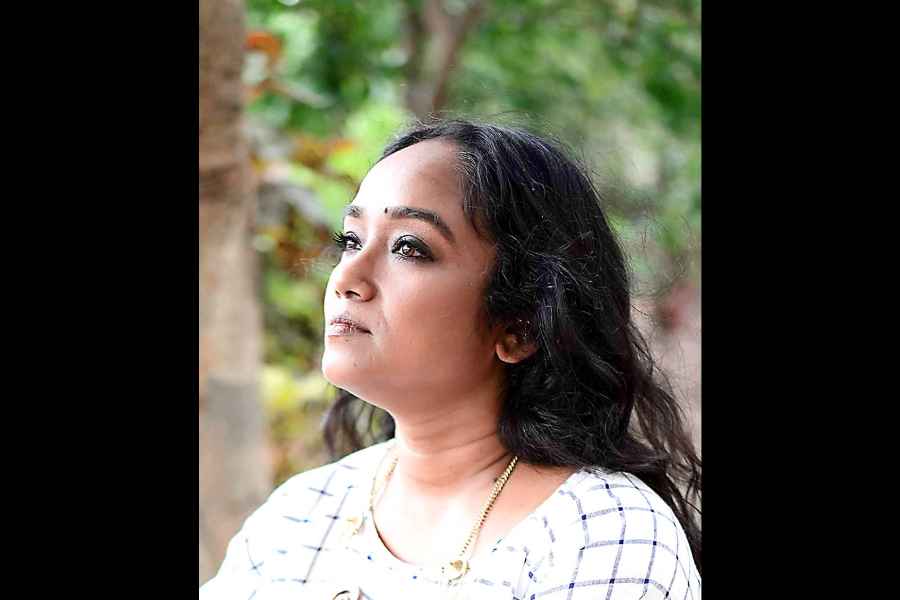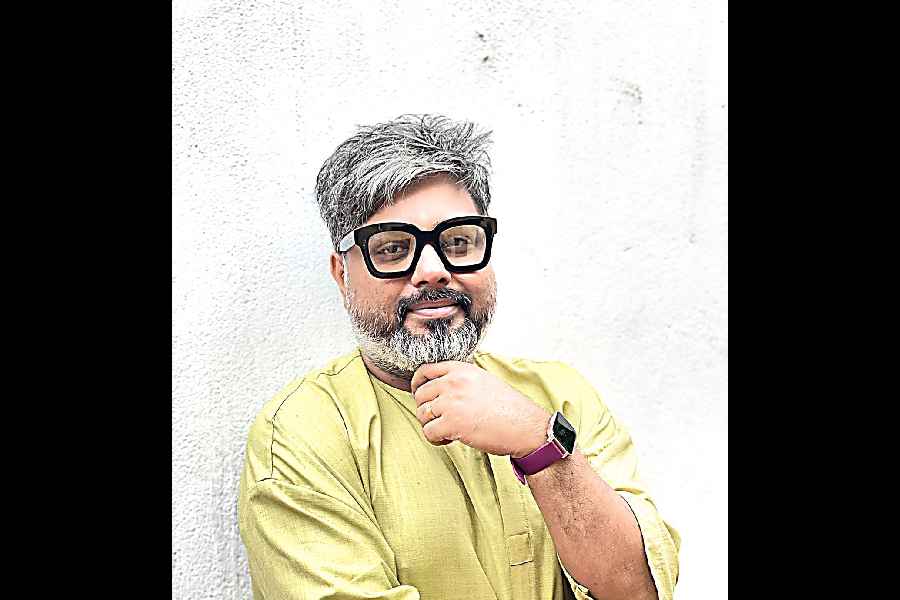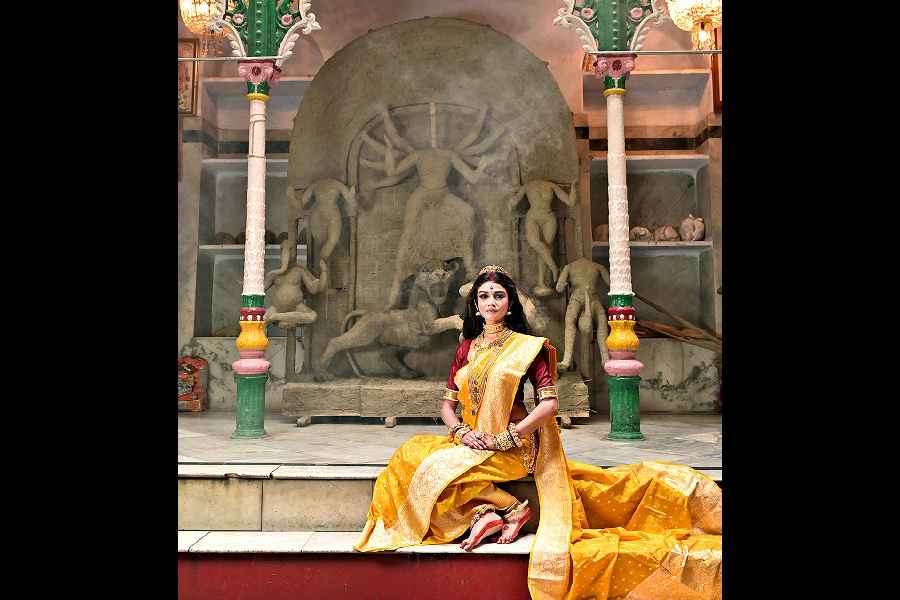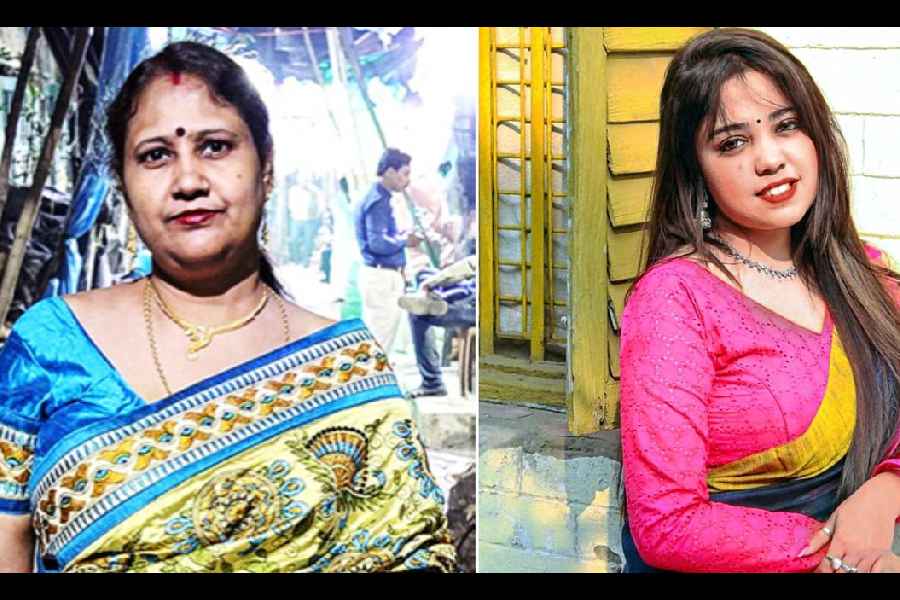When we look at the etymology of ‘fashion’, it directs us to the Latin word ‘facere’ or ‘to make’. Fundamentally, a designer makes a person fall in love with their body with how or what they make to adorn a body with. Writing on fashion for the past few years has made me believe fashion begins from the body, followed by outfits and other adornments.
So, a day ahead of Mahalaya, which marks the descent of the Goddess Durga on Earth, t2 through a fashion lookbook explored the Goddess in making. We start the lookbook with a shot in clay that shapes the body and end it with the complete look of the Goddess in all her adornments. To make this lookbook, apart from having people who put together a look in fashion — the designers, the stylist, the make-up artiste — we have also incorporated people who are responsible for getting the Goddess ready for the festival from the start till the end — the idol makers.
Fashion has always been an intrinsic part of the celebration of these five festive days in Calcutta. People’s fashion desires for these five festive days no doubt start from getting in shape and selecting outfits that embrace their bodies best. In this t2 lookbook, we celebrate this association right from where the process begins.
Sauraseni Maitra, our muse for this shoot, was a total sport in letting all the creative hands and minds behind this shoot create the looks on her.
The Clay Story:
It is said that the clay used in the making of the idol has significance in itself. “Earlier the clay (Ganga maati) used to arrive on a boat. Now, that doesn’t happen. We collect the straws for binding from Maa-er Ghat every year. The binding process of the straws starts in April. There are different types of clay that are used to make the idol. We use those clays in layers on the straw figure. First, a layer of dudhey maati is used, it is covered with a layer of beley maati, then again a layer of dudhey maati is used for the final structure. Etol maati is also used at times. Paat maati is usually used to strengthen the fingers of the figure and to cover the finer details on the figure,” said idol maker Gita Pal, who is now in charge of his late idol-maker husband Shyamal Pal’s shop in Kumartuli.

Artist Aditi Chakraborty
The Artist’s Hands:
Artist Aditi Chakraborty whose magic hands created this whole look from the background to cladding Sauraseni in clay to demonstrate the first stage in idol-making, which is creating the structure or figure of the idol, said: “When I do it on Ma Durga every year starting from the straws to drawing the eyes, I always think that in every woman there’s a Durga. Sauraseni is also such a woman! Imagining her as Durga and doing the work on the shoot floors was an exciting opportunity for me. It was a very interesting and experimental work that I felt happy to be a part of. The entire team worked on this together. Though idol-making is a different process, I could definitely relate to it while getting Sauraseni ready for this shot.”

“I am very emotionally attached to adorning an idol in general as I worship Maa Kali in my house every year. It is a very exciting part of the entire idol-making process when the idol gets ready to be presented. In the process of this shoot, we imagined Sauraseni as the Durga we are preparing to be presented. I am so thankful to t2 for selecting the locations so thoughtfully and Aditidi, who does this every year, helped us with the clay painting. Everyone worked together with their creative minds to get this shoot done. The last shot was all about creating the Mahalaya vibe. We had to be very careful with this shoot as people’s sentiments are attached to this process,” said Anupam Chatterjee, who styled the shoot.

The Idol Maker’s Workshop:
Our second chosen spot for the shoot was the idol’s first home, which is the idol maker’s workshop from where it is sent to different homes and pandals for worship during the five festive days. For this shot, Anupam draped Sauraseni in the traditional laal-paar-shada thaan made of modal silk with a raw silk border from Warssi Kolkata. While the idol’s finer details are getting its final touch in the maker’s hand, we imagined the idol clad in a thaan (the primary dress material) before getting draped in its festive attire and adorned with ornaments. Abhijit Paul chose brown smokey eyes, natural lipstick and a simple vermilion bindi with this look.
The Place of Worship:
For the final look at a worshipping place, we chose the Jorasanko Daw Bari. The Durga Puja of their house dates back to 1859 and was started by Narasingha Daw. The age-old tradition of worshipping Goddess Durga in this family is now being carried forward by the sixth-generation family members. For this final look, Anupam draped Sauraseni in a pure handwoven bright yellow katan silk Benarasi sari with silver zari work from Mitan Ghosh and paired it with a maroon blouse. Abhijit Paul went for a heavy make-up look with kohl eyes and tonged hair. Traditional gold jewellery from Anjali Jewellers completed her look.

“Our idol is prepared at home and our idol maker has been doing this for our family for years. We do this Puja following Baishnab rituals, so no sacrifice is made to the Goddess. Not even vegetables. Our family has been in the business of guns for generations and some of our worshipping rituals are unique to the family. One such ritual that is unique to the family is, though for all the festive days, the women of the house do the preparations for worshipping, for Ashtami’s sandhi puja it is the responsibility of the male members of the family,” said Koushik Daw, a fifth generation member of the family.

The Durgas behind making the Durga: The story of the Shakti rupenas:
In the lanes of Kumartuli, we found the late idol maker Shyamal Pal or as he was known to his clients, Bhola da’s workshop. The third-generation late idol maker’s work in this field is now proudly being carried forward by the two strong women in his family that he left behind — his wife Gita Pal and his 24-year-old daughter Nilanjana Pal. Maa Durga, also known as shakti rupena, symbolises positive energy and supreme power. While getting our shots done, we got to hear the story of these two real-life Durgas or shakti rupenas — a story of indomitable spirit and unflinching strength.
“My in-laws have been in this business for the last 150 years almost. I also come from an idol maker’s family. However, after marriage, my husband did not want me to take so much responsibility. So, I never involved myself actively in this work. But now that he suddenly passed away this year, I have decided not to stop the business but rather carry forward the good work he was doing. For 22 years, I have seen my husband do this work. Before him, his father and grandfather used to do so. Before my marriage, I used to work with my father. This year, despite the hard times we are going through as mother and daughter, we are delivering around 12 to 13 Durgas. Next year, I am looking forward to taking many more orders,” said a very confident Gita.
“The shoot was very exciting for me, especially where I had to draw the third eye. I had to be very careful with it as I was doing it not on a clay idol but on a human being. I had to draw it keeping Sauraseni’s face structure in mind and so I chose a white and a black liner to get the effects right. The whole shoot was a very interesting process. And we thoroughly enjoyed being creatively involved in this shoot together,” said Abhijit Paul, hair and make-up pro.
